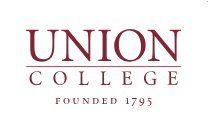Vantage Point 7: Flagpole / South College
The Flagpole /South College is the seventh of ten vantage points on a self-guided tour of Mrs. Perkins’
The area immediately below the Nott Memorial, later known as Library or Rugby Field, was the main athletic field at the time Mrs. Perkins wrote her letters. Mrs. Perkins often commented on Union’s athletic fortunes in her letters, which is perhaps not surprising, because she could see the games from the windows of her home in South Colonnade (the portion of the building with the pitched roof that is visible from the flagpole). On this field students played football and baseball; Union also participated in track and basketball in the period covered by the letters, when a dirt tennis court also stood in the place of the current Reamer Campus Center.
A major athletics controversy arose in the mid-1890s and was duly reported by Mrs. Perkins in her letters. After the football season in 1895, the faculty decided that students who were failing two or more courses should not be allowed to participate in athletics. The students were very upset and decided to go on strike against the athletics program entirely, thinking that their action would shock the faculty into lifting the restriction. However, Mrs. Perkins noted that this strategy left the students in a difficult position, for the faculty was actually fine with not having an athletics program. Eventually, the students yielded and accepted the new academic eligibility rule, but most of the spring 1896 season was missed because of the controversy.
South College was organized like North College, with faculty residences at each end and an overcrowded, uncomfortable student dormitory and recitation rooms in between. The faculty apartment at the northern end, which shared a wall with the Perkins/Hale residence in South Colonnade, was occupied at this time by the Stoller family. James Stoller was a Union graduate and a Professor of Biology and Geology, and his energetic young family was the source of some tension between the Stollers and Mrs. Perkins. She could often hear the children through the shared wall, and she considered the two mischievous Stoller sons not only loud and rambunctious but a bad influence on her grandson, Maurice Hale. On the other hand, Mrs. Perkins evidently had a keen understanding of the pressures and problems of residing in campus housing. Henry Whitehorne, the professor of classics who had lived in the faculty residence at the far end of South College since at least 1873, died in his eighties in 1901, and Mrs. Perkins noted with sympathy the difficulty his family had giving up their longtime campus home.
The area to the west of campus now occupied by parking lots, West College, and dormitories such as Richmond, Fox, and Davidson had no buildings on it at all at the beginning of the time period covered by Mrs. Perkins’ letters. Instead, this entire open area was known as The Pasture, and it was literally used for the grazing of cows and sheep, many of them owned by College faculty. Students and faculty children often played tricks involving the cows, but the favor could be returned: Mrs. Perkins reported that her son-in-law Edward Everett Hale Jr. was once chased across campus by a cow when he was on his way to visit her. Beginning in 1896, part of The Pasture was turned into a rudimentary golf course patronized by Hale and then-President Andrew Van Vranken Raymond, although the cows still provided a bit of an obstacle. During Mrs. Perkins’ time The Pasture was also reduced somewhat in size during the sell-off of campus lands under the measures adopted by College Treasurer Frank Bailey that sought to restore Union’s failing finances.
Map links: Athletic Field; Stoller; South College; Whitehorne; Pasture
Continue walking south towards Vantage Point 8, The President’s House / Hoffman House (now Feigenbaum Hall)

